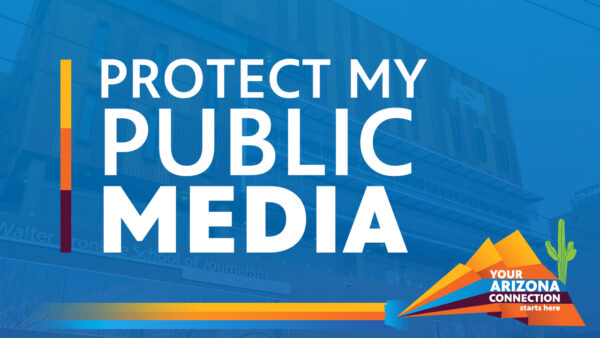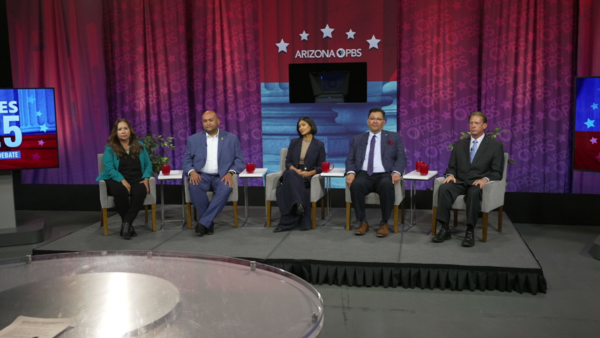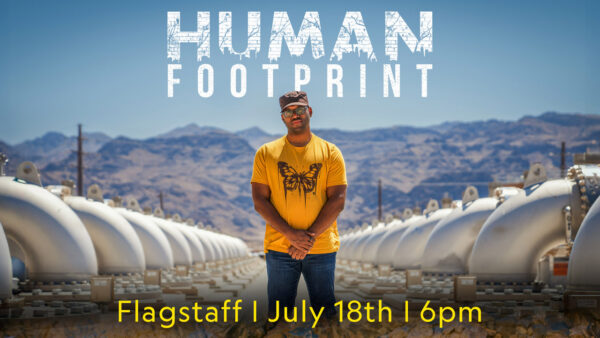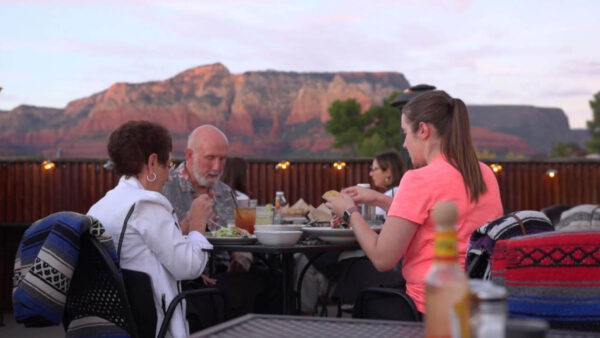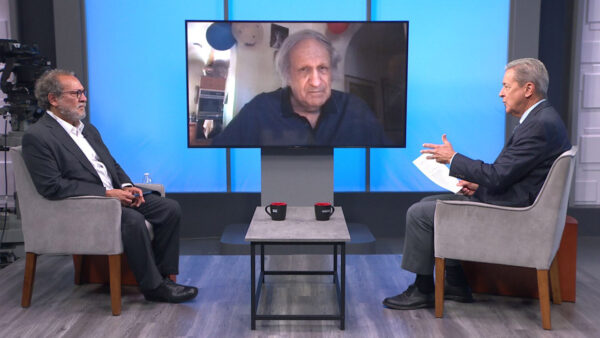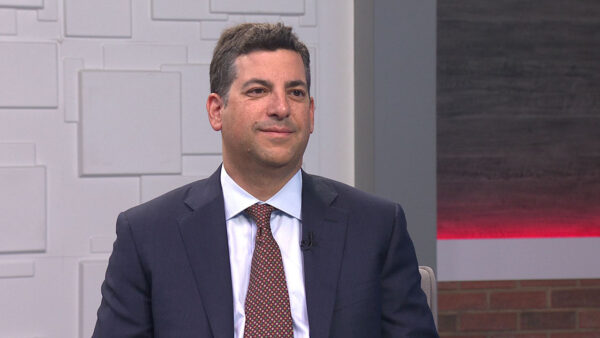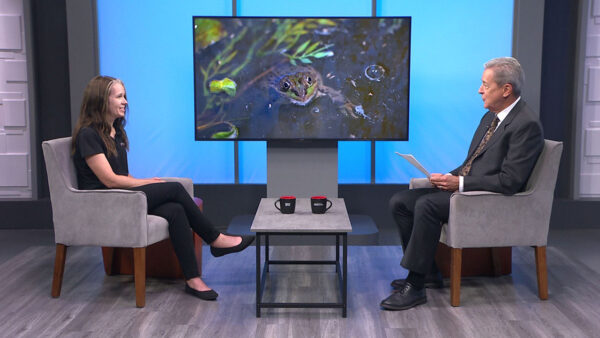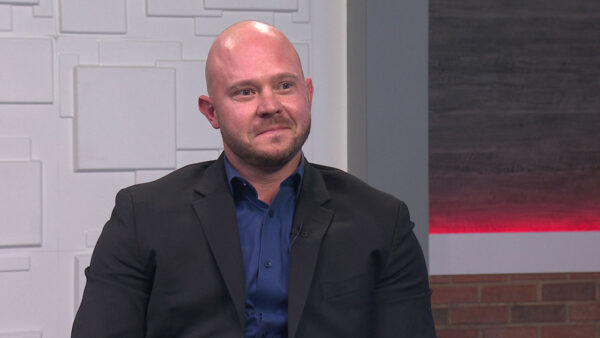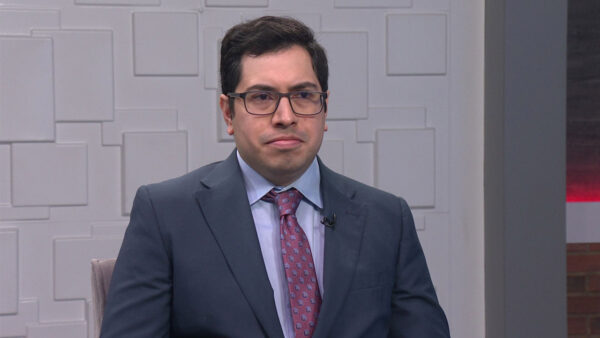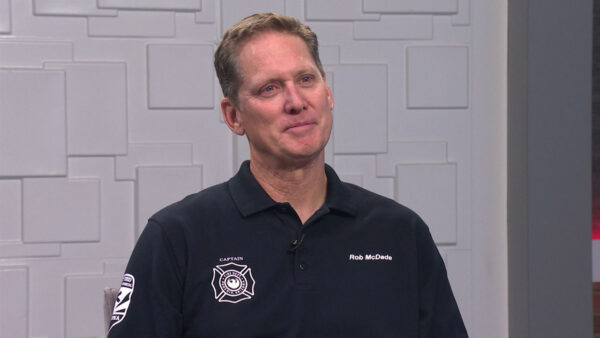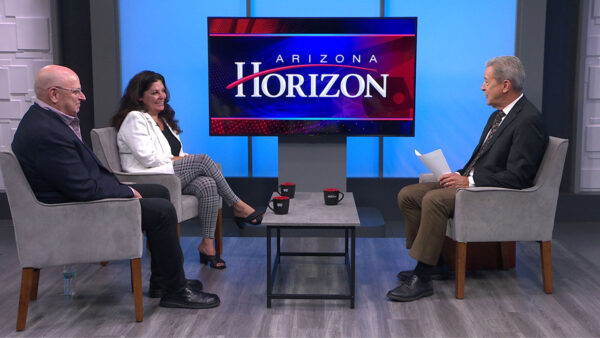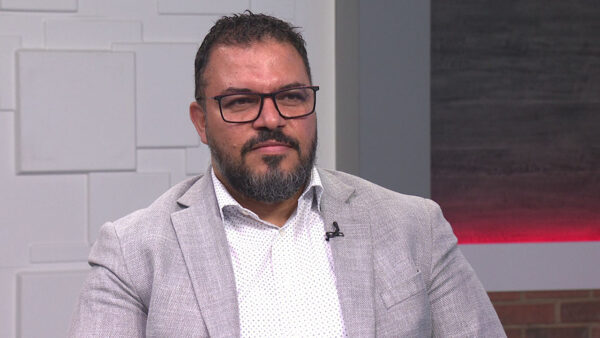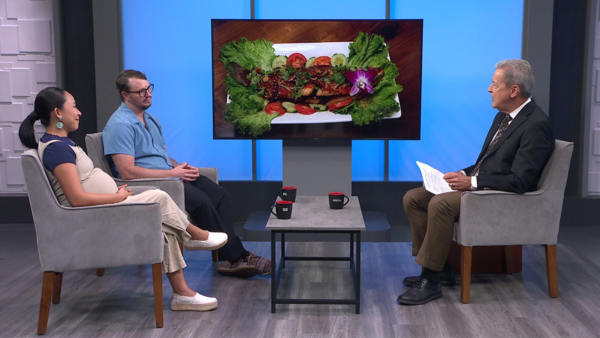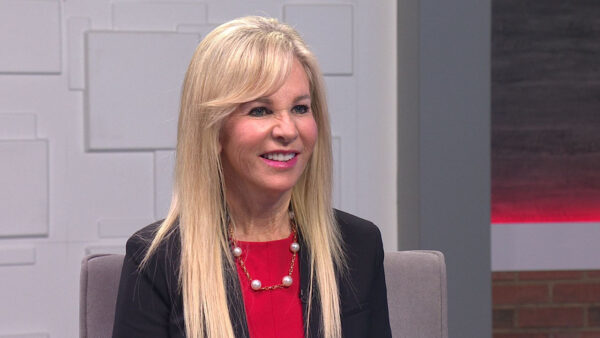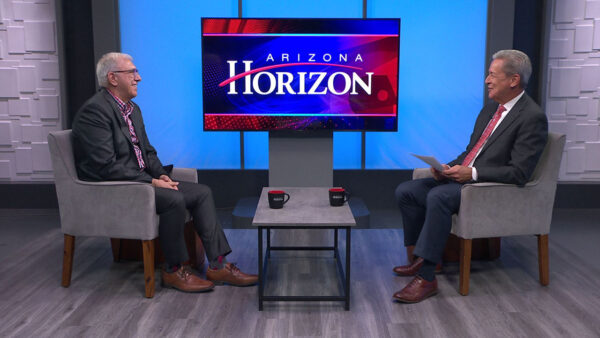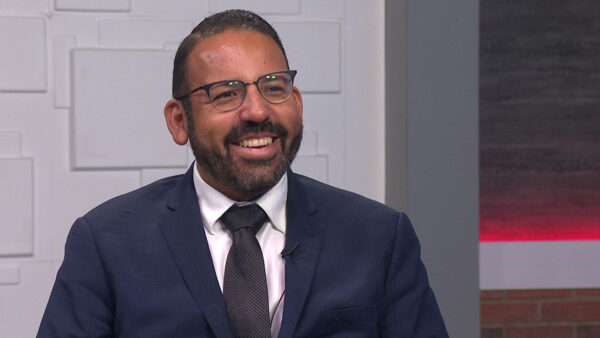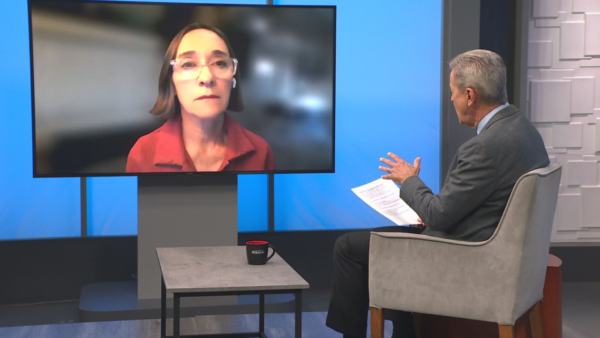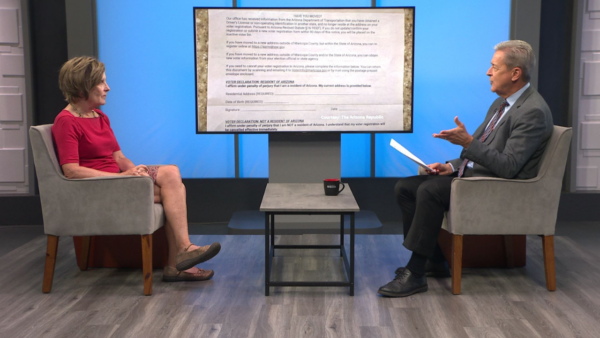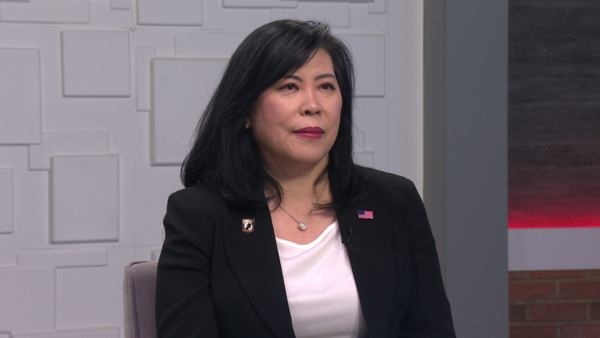As the Phoenix Open prepares to tee-off, golf Writer, Bill Huffman and Kris Strauss of OB Sports Golf Management talk about the economic impact of golf on the State of Arizona, how the recession is impacting business, and how the golf industry is adjusting to market conditions.
Ted Simons: The Waste Management Phoenix Open starts this week, good news for the Valley and an industry hit hard by the recession. Tonight we'll take a look at how Arizona's golf industry is doing in these tough economic times. First, David Majure takes us to a club in Scottsdale trying to weather the storm.
Mike Lindsey: We're privately owned.
Voiceover: Mike Lindsey is director of golf at McCormick Ranch Golf Club.
Mike Lindsey: 36 holes of championship golf, 40 acres of water. We have a real nice good-sized facility for people to come out and enjoy golf in the heart of Scottsdale.
Voiceover: McCormick's two championship courses are in a prime location surrounded by some of the Valley's finest hotels. But tourism is down and so is the supply of corporate golfers who used to come out for conventions and meetings.
Mike Lindsey: That's backed off, I'm guessing right on 50%. We're chasing individual golfers.
Voiceover: The chase is on as Arizona golf courses compete for fewer and fewer golfers.
Mike Lindsey: You've got to have good value and some good experiences to get the golfers to your course.
Voiceover: In the golf shop at McCormick Ranch advertised rates are far from reality.
Man1: I'm set up at 2:00 on the 3rd.
Ted Simons: Discounts are everywhere and online deals can offer savings of more than 60%.
Man1: You're paying for everyone?
Voiceover: Buy a PGA Southwest section pass in the golf shop for about $100 and you'll get coupons for two free rounds of golf and 50% off for the rest of the year. The value has helped with volume. Rounds are up about 10% compared to last year at this time.
Mike Lindsey: We're up in rounds and down maybe anywhere from 8% to 10% in revenue.
Voiceover: But the news is much worse for courses on the outskirts of the Valley.
Mike Lindsey: Area golf courses are I would say struggling to maybe 50%, if we're going to put a percentage on it, too. There are a lot of places that went into foreclosures and are changing management and getting repurchased. Going back to the old school "location, location, location," with McCormick Ranch right in the heart of Scottsdale, we have weathered the storm, as they say. We're up about 10% in pro shop sales as of January 1, 2010, over last year. We're seeing a little increase, but we need to get those people back into the Scottsdale-Phoenix area and doing some corporate traveling and leisure traveling, so important to this valley, too.
Ted Simons: Here now to talk about golf in Arizona are Kris Strauss, director of sales and marketing for O.B. Sports Golf Management, a company that runs seven golf courses in Arizona, as well others in 15 states. And Dick Hyland, president of Dick Hyland Golf, which provides consulting services to public and private clubs and golf course managers. Welcome, good to have you.
Kris Strauss: Thank you.
Ted Simons: Let's start with a general question, the state of golf in Arizona.
Kris Strauss: The state of golf in Arizona has been impacted negatively like every industry. And it's been challenging. You know, we've had our -- really our biggest issue is our mix of players has changed. We have a lot less tourism and a lot less people staying in the resorts, spending money on conferences and conventions and playing golf at a higher green fee price. We've had to replace those rounds, if you will, with a lot more localized play or a lot more play from our backyard. That'll drive a little lower green fee price, which squeezes the owners and operators. We're a pretty slim margin business. People don't realize that. There's a perception that golf courses are making money hand over first; usually we're just trying to get by. When you have a change in the mix like the past couple of years, it puts our operators in a very challenging position.
Ted Simons: State of the golf industry in Arizona.
Dick Hyland: Much like the nation, we're following that trend. Every day we get one day closer to getting out of this mess we're in right now. It gives this state an opportunity to expose itself to a lot of different people coming to the state to play golf at valuable prices, and it's a good time.
Ted Simons: Rounds are up but revenue is down. Explain.
Dick Hyland: I think a lot of golf courses are getting as much as they might hope or budget for, but the amount of guest fee and retail revenue per player is not there as it once was. When they talk about rates are down but the amount of play is reasonably flat, I think that's about what they can expect.
Ted Simons: You had mentioned that people don't realize the margin, how slim it is. You hear all the time, the rates are too high. I can't afford to play, they need to drop them and I'll play more. How do you respond?
Kris Strauss: The best way to respond to that, the tourists or high-rated business kind of subsidizes the lower rate structure we offer to our resident golfers, and even our loyal golfers playing with a frequency program or a loyalty program. Those folks paying a higher dollar, a large group or a corporate event, are making it more affordable for the resident golfer. I think we are providing affordability, today now more than ever. You can play some great golf courses in Arizona at a very fair price. Now is the time to play some of these spectacular courses.
Dick Hyland: I think there are two plans out there. There is one plan, like the airlines, the farther in advance you book the better rates you get. Anymore it seems like the closer to the time you want to play, the better rate is available. You have to figure out which plan you're going to go with and hopefully stick to it. Your responsibility is to fill up that course with as many golfers as you possibly can. Case in point, one club I called and asked what the rate was. Rack rate was $190 a round. If I call you three hours in advance, tee time open, what can I play for it? He said $60.
Ted Simons: The online discount rates on these sorts of things, used to be, I'm going to go to Phoenix, I want a round for three months from now, can you book it. I can book it. Now seems like folks are seeing what kind of deal they can get, which means the course kind of sits there and waits.
Dick Hyland: The consumer is waiting on the last minute, as best I understand, Kris, to see what the best value and the best price is.
Ted Simons: The economy, as you mentioned, as well, in bad straits. It hits baby boomers. They have their 401(k)s not doing all that well. Golf is usually a sport you can play well into your later years. Is the impact strong on that level?
Kris Strauss: Sure. Certainly the baby boom, and statistics show the National Golf Foundation stats show as you age you play more golf, and you can play more rounds, frequent the golf course more often. Certainly when the economy does go down in all aspects, it'll hit that group, as well. That makes it challenging. I think we as operators and owners need to do all we can to develop new and younger golfers and get more players into the game. As the core golfer ages we have players that come into the game to replace those rounds. At the same time, still do all we can with reprogramming to make sure we're doing all we can to give best value to our loyal golfers, who might be in that baby boomer age bracket, who frequent every week.
Ted Simons: Is that a problem with golf right now, the idea that it needs to freshen its image a little bit and get younger golfers? Or is the industry working on that, and it's not happening as fast as you would like?
Dick Hyland: In every industry we're in a never-ending marketing phase where we have to promote our business as best we can. We need to cultivate the junior golfers, family golfers, et cetera, et cetera, and get as many people out to experience the game we all love and enjoy, and have a good time playing it.
Ted Simons: You were involved for years with Desert Mountain, a spectacular course and project and development in Scottsdale. Talk about real estate development, the relationship between real estate development and golf courses, where it was, where it is.
Dick Hyland: Well, the developer I started with, Lyle Anderson, was one of the first to come up with the concept of a private club within a real estate community. At that time he bundled together the membership within the home sale or the lot price. At that time it was very, very good. Now it's a little bit more difficult in these economic times. We're seeing that many homes are for sale for far less than they were at one point. That the private club membership has been lowered from an initiation fee that was once quite high to now where I think the going market pricing, and trying to get as many members in the door as they possibly can.
Ted Simons: The idea of private courses going public, at least for the time being, good idea?
Kris Strauss: I think it's a necessary idea. I think that the real estate sales you alluded to earlier, Dick, are not there. Oftentimes that's what subsidized a lot of the golf operation. Until that recovers you need to figure out a way to keep the golf operation viable and sustainable so you can continue to provide great courses and good experiences for your current members and golfers. If it's done right, it can introduce potentially a member to your course. Someone who's coming to pay $150 green fee might have a look around and say, I'd love to live in Arizona or buy a second home here. It's going to keep our ships afloat, if you will, and might create a new opportunity we haven't seen in a lot of these private club communities.
Dick Hyland: As well as the revenues generated by opening up the course to members and guests, you've got so many more eyes on your property that ultimately might want to be a member. If you've got a hundred players as day you might not normally have had, and they say, I had no idea this club was this beautiful, that the services are spectacular, I'm going to inquire about a membership. Beyond the ancillary dollars that come in from guest fees and cart fees and food and beverages, it's trying to build members to full capacity.
Ted Simons: How many eyes do you need to take care of rising costs of water? How important is water to the golf industry?
Kris Strauss: It's vital. We need green grass for tourists to come to Arizona and help support this $3.4 billion industry in this state. We need water to keep our 19,000 Arizonans employed in the industry that are employed currently in this industry. There's a perception that water is probably overused on a golf course. But thankfully water costs us money so we're going use it with very -- with conservation in mind all the way. And the irrigation systems have never been as sophisticated as they are today. Water usage represents about 1.5% of the water usage in our state. What our issues are are costs. The higher costs, even if it is effluent water or whatnot, it's going to continue to put pressure on course operators because the margins are slim and we're going to be having to find other ways to get things done and to keep our courses open and green for tourists and whatnot.
Dick Hyland: Kris was alluding to, we're going more and more to the effluent water, getting away from well water and CAP water, et cetera. I'd like to mention the fact of how important the superintendent is and how diligent and disciplined they must be to conserve water as best they possibly can. We are seeing a case in point, there are trends where not as much over seeding is being done, only over seeding fairways and roughs. You definitely save a lot of money.
Ted Simons: Last question, quickly. Are there too many golf courses in Arizona?
Dick Hyland: No, there just aren't enough golfers.
Ted Simons: There are too many golf courses in Arizona?
Kris Strauss: I agree, there is probably a need for more development. You're going to see a shrinkage of golf courses. Nationally we've had four years of net decreases in golf courses. You're going to see repurposing of golf courses. Yes, we're undersupplied -- oversupplied and with a very static demand since the late '90s. And also the good managers of our courses that are owners have had millions --
Dick Hyland: In the late '90s and early 2000s are when they came on with golf courses. It's our responsible to sell as much land as we possibly could. With the glut in the market we have to wait until this inventory dissipates before we can actually catch up. Certainly golf in Arizona is as good as it gets.
Ted Simons: Gentlemen, we appreciate it.
Bill Huffman:Golf Writer;Kris Strauss:OB Sports Golf Management;
